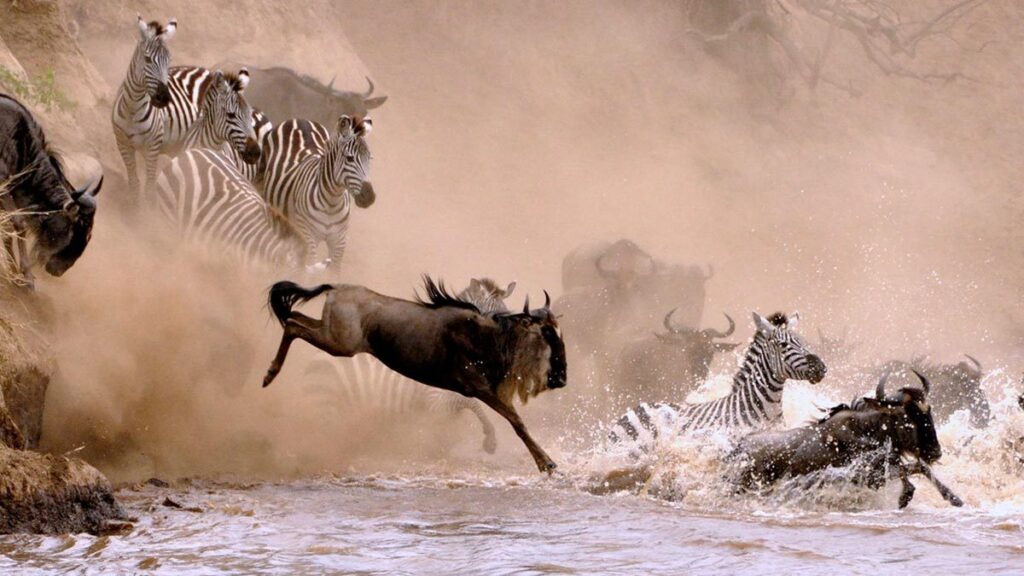The Great Wildebeest Migration stands as one of the most awe-inspiring events in the natural world. Each year, millions of wildebeest, along with other herbivores like zebras and gazelles, embark on a journey of survival across the plains of East Africa. Here, we delve into the intricacies of this remarkable phenomenon, including the best time to witness it, the migration cycle, tour packages, fascinating facts, and more.
Best Time to Visit & See the Great Wildebeest Migration
For those yearning to witness the grandeur of the Great Wildebeest Migration, timing is everything. The migration typically occurs between the months of July and October when the herds traverse the Serengeti plains in Tanzania and the Maasai Mara National Reserve in Kenya. This period marks the dry season, prompting the wildebeest to seek greener pastures and water sources, making it the optimal time for visitors to observe this natural spectacle.
Understanding the Great Wildebeest Migration Cycle & Map
The Migration Route
The migration route covers a vast expanse, spanning approximately 1,800 miles (2,900 kilometers) in a circular pattern. The journey begins in the Serengeti, where the wildebeest gather in massive herds, driven by the instinct to seek fresh grazing lands. They then trek northward towards the Maasai Mara, crossing perilous rivers such as the Mara and Grumeti, braving crocodile-infested waters and facing predation along the way.
The Key Locations
Within this migration route lie several key locations that serve as pivotal points in the journey. The Serengeti National Park in Tanzania and the Maasai Mara National Reserve in Kenya are the primary destinations where the migration can be observed in all its splendor. These protected areas offer unparalleled opportunities for wildlife enthusiasts and photographers to witness the drama unfold against the backdrop of the African savanna.
Our Wildebeest Migration Tour Packages
To experience the Great Wildebeest Migration up close and personal, consider embarking on one of our tailor-made tour packages. Whether you prefer a luxury safari adventure or a budget-friendly excursion, we offer a range of options to suit every traveler’s needs. Our experienced guides will lead you on unforgettable safaris, ensuring you witness the migration in all its glory while providing insights into the wildlife and ecosystems of East Africa.
Facts About the Great Wildebeest Migration
- The migration involves over 1.5 million wildebeest, accompanied by hundreds of thousands of zebras and gazelles.
- Wildebeest calves are born en route, adding to the spectacle of the migration.
- Predators such as lions, cheetahs, and hyenas closely follow the herds, preying on the weak and vulnerable.
- The migration is driven by the availability of food and water, as well as instinctual behavior passed down through generations.
More About the Great Wildebeest Migration Route
The Great Wildebeest Migration route is a marvel of nature, shaped by millennia of ecological processes. It encompasses diverse habitats, including grasslands, woodlands, and riverine forests, each playing a crucial role in sustaining the migrating herds. The route’s topography, combined with seasonal weather patterns, influences the movement of the wildebeest and other herbivores, creating a dynamic and ever-changing spectacle that captivates observers from around the world.
How the Wildebeest Migration Works
The Great Wildebeest Migration is a testament to the resilience and adaptability of wildlife in the face of environmental challenges. It is driven by instinctual behaviors honed over generations, as well as the need to survive in a harsh and unforgiving landscape. As the herds move in search of food and water, they leave a trail of hoofprints that echo the rhythm of life on the African plains, reminding us of the delicate balance between predator and prey, life and death.
Conclusion
In conclusion, the Great Wildebeest Migration stands as a symbol of nature’s grandeur and the interconnectedness of all living things. It is a testament to the resilience of wildlife and the enduring spirit of survival in the face of adversity.


